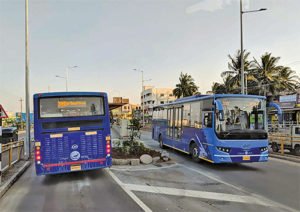 Though Indian BRT networks have not fared as well as their international counterparts, the system has a chance at redemption with the Hubballi-Dharwad BRT. Still on a trial run, HDBRTS has been working its way across the twin cities and through people’s travel needs in a phased manner.
Though Indian BRT networks have not fared as well as their international counterparts, the system has a chance at redemption with the Hubballi-Dharwad BRT. Still on a trial run, HDBRTS has been working its way across the twin cities and through people’s travel needs in a phased manner.
When the Hubballi-Dharwad bus-rapid transit system (HDBRTS) began its trial run in October 2018, it offered a great sense of relief and excitement to commuters in the twin cities. Another group which welcomed the launch was of transport experts and enthusiasts, who had been anticipating the launch with bated breaths.
The 22-km project, which extends high-quality transit services between Hubballi and Dharwad, saw a four-year delay due to various reasons. Now months after the system’s trial run, doubts are being slowly put to rest as the HDBRTS inches closer to the coveted ‘Gold’ ranking — conferred as per the BRT Standard.
The BRT Standard and why it matters
BRT systems help in the fight to reduce transportsector emissions and offer affordable, comfortable and convenient transit to all. The BRT Standard, an expert-reviewed scorecard, was developed to create a common definition of BRT. Considered a magnum opus in BRT design, the Standard is an evaluation tool based on international best practices. It looks to ensure corridors can uniformly deliver world-class passenger experiences.
Start with the basics
As cities rush to develop bus-based rapid transit systems, many remain unaware of the characteristics of BRT corridors and how it can match metro systems. Hence, it is essential to get the basics right and then add features to improve the system’s high-quality. Here are the five basics that are fundamentals to a BRT system:
 1. Dedicated right-of-way – A dedicated right of- way ensures buses can move quickly and unimpeded by congestion.
1. Dedicated right-of-way – A dedicated right of- way ensures buses can move quickly and unimpeded by congestion.
2. Busway alignment – The busway is best located in the central section of the carriageway where conflicts with other traffic is minimal, especially from turning vehicles, on-street parking, property entrances, street vendors, etc.
3. Off-board fare collection– Off-board fare collection improves reliability and reduces dwell time at station. The system can employ either ‘barrier-controlled’ or ‘proof of payment’ to collect fares.
4. Intersection treatments– Since free-flowing bus movement is essential, intersection priority is a must. Improved signal phasing for the bus-only lanes ensures better bus movements.
5. Platform-level boarding– Having the bus station platform level with the bus floor is key in reducing boarding and alighting times per passenger. It even ensures accessibility for all.
Beyond Basics: how BRTs can strike gold
The BRT Standard establishes best practices and features cities and systems which are exemplary in bus-rapid transit. The intention is to guide other cities and help them create their own identity and push the standards. So how does a city set the benchmark beyond just creating a basic BRT system? Here are supplemental elements which can help set a mark:
 • Service matters, a lot
• Service matters, a lot
Like any service system, what matters the most is the BRT system’s ability to serve people. Hence, factors evaluated are based on how well it meets the demand, efficiency of service, and the extensive coverage it offers. Passengers can be served best when the system offers multiple routes within and beyond the corridor(s); has in place services such as express and limited stops; creates control center(s) to ensure smooth sailing; serves highdemand areas; and has extended hours of operations.
 TrafficInfraTech Magazine Linking People Places & Progress
TrafficInfraTech Magazine Linking People Places & Progress


